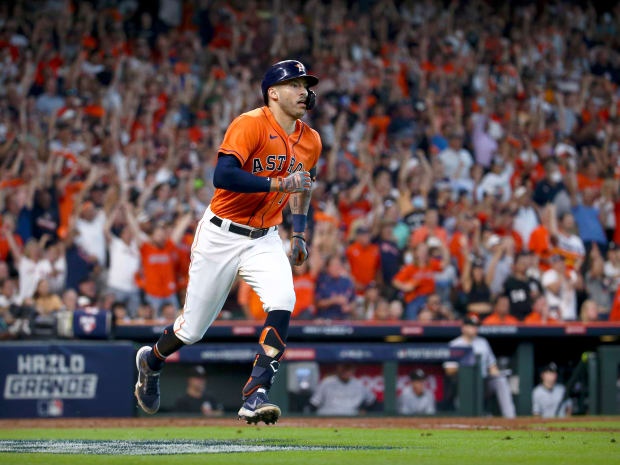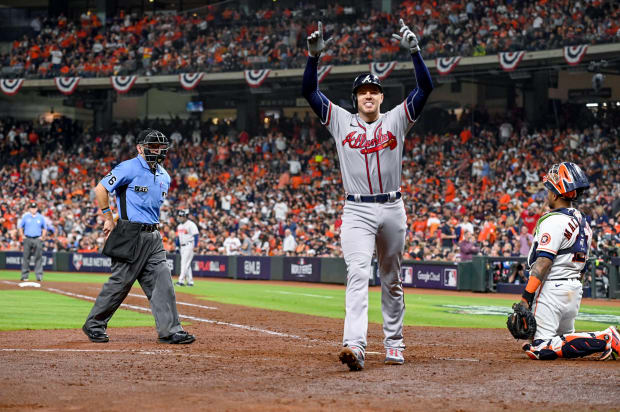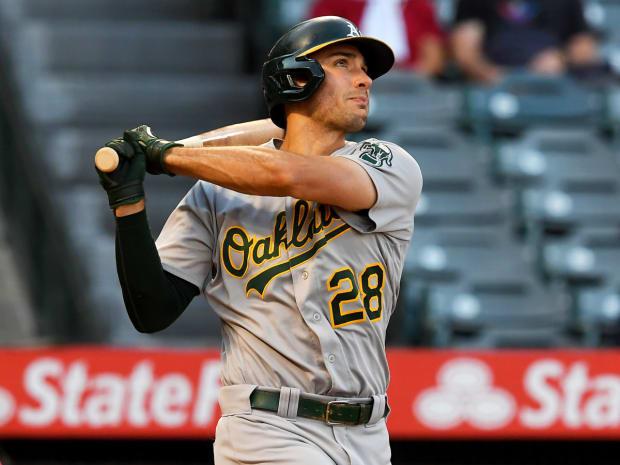Today is a great day. I’m listening to “Take It Easy” as I begin this newsletter, temperatures in Brooklyn are in the 50s, and all of us get to look forward to some baseball.
This paragraph is the last in which I’ll mention the lockout in this introduction section. You can read more about the new CBA deal and what it means for MLB and the players later in the newsletter. Instead, let’s talk trades, free agency and, you know, BASEBALL.
Here are three things you should be following as camps open, transactions begin and spring training games get going.

Troy Taormina/USA TODAY Sports
Where does Carlos Correa sign?
Correa is the most exciting free agent to watch in the coming days. He’s the most talented player available, he’s only 27 years old and he’s a four-plus tool shortstop (speed being the one area where he’s about average) with plenty of postseason experience. For all of these reasons, he should command the biggest deal.
Corey Seager set the free-agent market for top-tier shortstops at 10 years, $325 million when he signed with the Rangers back in late November. Seager is the better hitter, but Correa is the better all-around player, so you should expect Correa to sign for more money. The question is whether he can top the 10-year, $341 million extension Francisco Lindor signed with the Mets before the start of the 2021 season, which stands as the record contract for the position.
The calculus does change a bit with the new CBA’s raising of the first Competitive Balance Tax threshold to $230 million for this season—$20 million more than it was last year. Teams that were using the threshold as a salary cap (read: almost all of them) now have more to spend before reaching it. Plus, there are now six playoff teams per league (up from five each), so you could see more teams active in free agency with the hope of improving their rosters just enough to snag the final wild-card spot. This bodes especially well for Correa, as younger teams who are still a year or so away from contention could decide to splurge this offseason for a franchise shortstop.
The Cubs, for example, have been linked to Correa. As their roster stands, they are probably the third-best team in the NL Central, and in the 7–9 range overall range in the NL. They have plenty of money to spend—after their 2021 trade deadline fire sale, their current estimated luxury tax payroll is $126.8 million, per Spotrac. Signing Correa automatically boosts them into a wild-card contender, and they’ll still have room to spend to improve the rest of their roster.
The Yankees and Dodgers are the other two favorites to land Correa. New York has a big hole to fill at SS now that Gleyber Torres is back at second, and Correa—who doesn’t strike out much—would do a lot to balance out the whiff-heavy lineup. One potential problem: The Yankees’ top two prospects, Anthony Volpe (age-21 season) and Oswald Peraza (22), are both shortstops who are advanced for their young ages. New York might not want to give Correa a 10-year deal with those two in the pipeline and other roster areas to address.
The Dodgers lost Seager to free agency, and they have Trea Turner to slide back over from second to short (his natural position) to fill the void. But Turner is a free agent after this season; they could sign Correa as their franchise shortstop and have Turner start at second. Los Angeles is projected to have a payroll above the CBT threshold, but the Dodgers are one of the rare teams that aren’t concerned with paying the tax rate.
A few other teams that could be in on Correa:
- The Astros, who are still very much a contender in the AL and could try to bring him back now that they have $20 million more luxury-tax space.
- The Phillies, who love to spend stupid money and need to fix their woeful infield defense.
- The Angels, because who needs pitching, anyway?
- The Red Sox, who could move Xander Bogaerts over to second base.

Greg Nelson/Sports Illustrated
Will the Braves re-sign Freddie Freeman?
This once seemed like a foregone conclusion. They just won the World Series. Why the heck wouldn’t they bring back their franchise first baseman? But Atlanta didn’t re-sign him before the transaction freeze (told ya I wouldn’t mention it again in the intro!), leaving open the possibility for another team to swoop in. It’s absurd to think the defending champs would decide not to pay Freeman—especially after their immensely profitable title season—but that’s exactly what I expect to happen.
The Yankees are the perfect fit for Freeman. They need to add at least one left-handed hitter to their lineup and they need to upgrade at first base; Freeman addresses both concerns. It’s true they have Luke Voit, who led the majors in homers in 2020, but injuries kept him off the field for most of last season, leaving his long-term status with the team in question. Plus, he bats right-handed and is not a good defender. He projects better as a designated hitter, and with the institution of the universal DH, NL teams could be interested in trading for him.
New York’s luxury-tax space is approximately $8.6 million, per Spotrac, which calculates Freeman’s market average annual value to be $27.1 million. But it’d be pretty sad if the CBT kept the Yankees from signing one of the best players in baseball.
The Dodgers are also among the favorites to sign Freeman. They could use another lefty hitter now that Seager is gone. This is what their lineup could look like with Freeman.
- Mookie Betts, RF
- Trea Turner, SS
- Freddie Freeman, 1B
- Justin Turner, 3B
- Max Muncy, 2B
- Will Smith, C
- Cody Bellinger, CF
- Chris Taylor, LF
- AJ Pollock, DH
Let’s pause for a second to laugh at the ridiculousness of the newly implemented fourth CBT threshold ($290 million in 2022), which has been dubbed the “Steve Cohen tax.” It’s quite funny that MLB created an entire level to curb one owner’s spending; it’s even more hilarious to think that such a tax rate is actually going to work on Cohen.
That’s why we shouldn’t rule the Mets out in the Freeman sweepstakes. I haven’t heard anything yet indicating that they’re making a push for him, but he’d be a great fit. With Freeman at first base, Pete Alonso would be the everyday DH, which is currently expected to be a platoon of J.D. Davis vs. lefties and the shell of Robinson Canó vs. righties. The added bonus would be making sure Freeman doesn’t re-sign with the Braves, go crosstown to the Yankees or join the Dodgers juggernaut.

Jayne Kamin-Oncea/USA TODAY Sports
Which players are likely to be traded?
The signature A’s sell-off is here. They aren’t expected to be relevant in the playoff picture for the next few seasons, by which time first baseman Matt Olson will no longer be under club control—and you can be sure they won’t sign or extend him. If the Yankees miss out on Freeman, look for them to trade for Olson. The chiseled slugger turns 28 at the end of this month and has two more seasons before hitting free agency. His left-handed power stroke is a natural fit for Yankee Stadium, and he’s an elite defender, too. The Yankees need more than just help at first base, so trading for Olson and then signing, say, Correa or Trevor Story to upgrade at shortstop could be the better option than signing both Freeman and a top-tier shortstop.
The A’s and Reds hold the keys to the starting pitching trade market. Oakland has three solid starters on the block (Frankie Montas, Sean Manaea and Chris Bassitt),’ while Cincinnati is looking to deal a pair of aces (Luis Castillo and Sonny Gray). The list of potential suitors could include but are not limited to the Angels, Braves, Mariners, Rangers, Padres, Phillies and Yankees.
Remember when the Pirates had two starters on the 2021 NL All-Star team? They traded one of them, Adam Frazier, to the Padres last July (Frazier is now with the Mariners), and it shouldn’t be long before they trade the other one, center fielder Bryan Reynolds. The 27-year-old won’t hit free agency until after the ’25 season. A switch hitter, Reynolds hits for average and power, runs well and plays good defense. He reportedly turned down two extension offers before the ’21 season, so if the rebuilding Pirates can’t keep him long term, now is the time to trade him to maximize their return. The Yankees, Red Sox, Phillies and Braves could use a center-field upgrade.
Bonus breaking news
Just as I finished writing this newsletter, Carlos Rodón signed a two-year, $44 million contract with the Giants, according to ESPN’s Jeff Passan. This is a great move for the Giants, who needed one more starter to round out one of the best rotations in the league. Let the frenzy begin!
Have any questions for our team? Send a note to mlb@si.com.
1. THE OPENER
“There was something thrilling, as in an amusement ride that sends you upside down, of surviving what seemed like the brink of disaster.”
That’s Tom Verducci from last night, writing about the new CBA and the end of the lockout. He explains why the deal is a win for everyone involved and calls for a “true partnership” between the players and owners. You can read his entire column below.
Baseball Avoids Disaster Just in Time for a Fresh Start by Tom Verducci
2. ICYMI
The Battle for Baseball’s Soul Continues by Stephanie Apstein
There are structural problems with the sport as it exists right now, and the new collective bargaining agreement did little to address them: You can’t legislate doing the right thing.
The MLB Lockout Is Over. Now the Chaos Begins. by Emma Baccellieri
Get ready for a free-agent frenzy, a mad dash of trades and spring training games. The next month is going to be baseball like you’ve never seen it before.
Here Are the Most Important Details in the New MLB CBA by Dan Gartland
3. WORTH NOTING from Stephanie Apstein
One element of the new CBA that will be interesting, especially for AL East teams: Players who miss games because of vaccine requirements—such as, for example, in Canada, where the border is closed to unvaccinated people—will not receive pay or service time for those missed games. This may influence some roster decisions.
4. TRIVIA! from Matt Martell
Before we get into this week’s question, here is the answer to the one I asked last Friday.
Last Week’s Question: Which player accumulated the fewest WAR for the season in which he won the MVP award?
Answer: Willie Stargell, 1979, 2.5 WAR
This Week’s Question: Who was the last pitcher to get a hit before this upcoming season’s implementation of the universal DH?
5. THE CLOSER from Emma Baccellieri
The last few months have been focused so heavily on all that ails baseball—on how the game needs to change, on how it isn’t changing, on broader existential issues that can’t be solved in one CBA. None of that disappeared when the lockout ended yesterday. But it did break for a moment. For the first time in weeks, it felt easy to focus instead on everything that makes baseball so special—to revel in the excitement of players reporting to camp, even if a month late, and in the glorious promise of a full season. Which, yes, is a little cheesy. But it’s also genuinely lovely. May you hold on to that feeling, and experience more of it in the six months to come.







